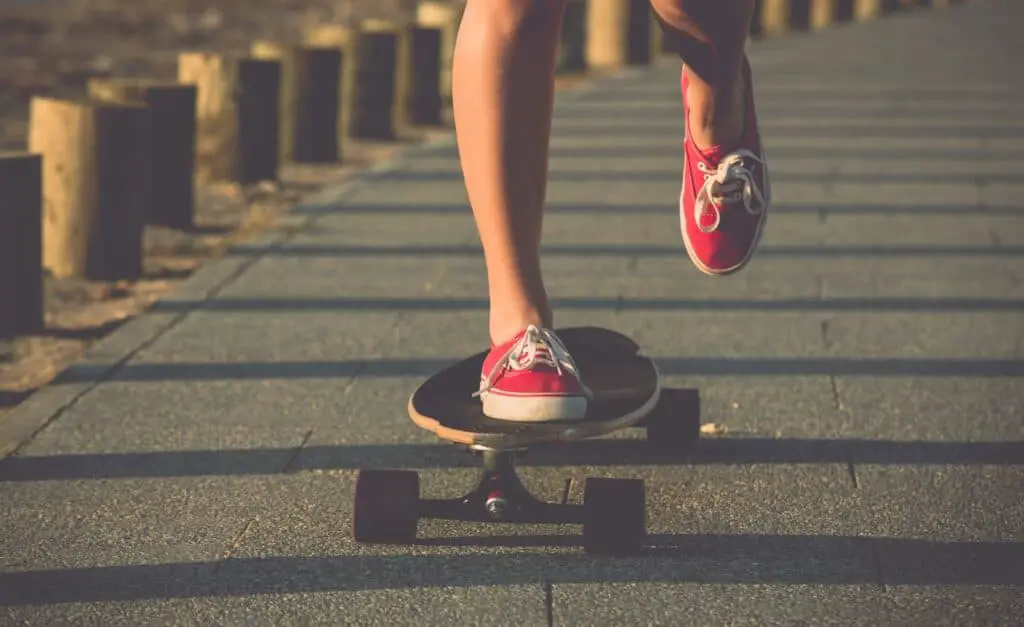Skateboarding is one of those activities that seems fun and easy to learn. Once you step on one for a ride for the first time, you might find that reality has a different story to tell.
When you step on a skateboard, you need a combination of rhythm and balance to have a successful ride. Even when your goal leans toward transportation instead of tricks, it takes some time to get used to how your body feels on wheels.
Longboards are suitable for beginners because they offer a stable surface with added durability. You’ll find that it is much easier to discover your center of balance when using this deck.
That’s why a longboard is a reasonable compromise to consider. It provides your skateboarding experience with a larger gravity well to help every beginner see if this activity and sport are something they’d like to pursue more.
What Type of Long Board is Good for Beginners?
When you start shopping for the best longboards today, you’ll discover that eight common shapes are available. Pintails and kicktail are very popular.
Although you can theoretically use all of them successfully, beginners typically need a longer frame and a broader base to make the learning process more comfortable. That means your best longboard style would be the “double kick popsicle.”
This longboard shape is the closest one to a traditional skateboard. It doesn’t have tapering at the nose or tail, uses the standard truck (wheel) design, and has enough flexibility to absorb road or sidewalk vibrations.
As you shop for the best longboards for beginners, you’ll want to consider a product with at least 30 inches of length to support the learning process.
Older teens and adults who want to learn how to ride might consider something more extended to support their balance. The best designs in this category could be up to 46 inches long.
Although smaller choices are an option, those shorter longboards have less stability.
What Are the Pros and Cons of Using Longboards?
Most longboards use a drop-through design, which means the trucks get mounted through the original board. This option is the most popular because it replicates a traditional skateboard’s feeling while offering more forgiveness.
You can learn in each direction to get the movement you want without having the board fly out from underneath your feet!
The extended length of a longboard also creates a weak point in its center, right where you have the lower gravity well for your ride. Unless you purchase a reinforced board, you’ll face a higher risk of it cracking, snapping, or failing in other ways.
Here are the other pros and cons of using longboards that you’ll want to review before purchasing your first one.
| Advantages of Using Longboards | Disadvantages of Using Longboards |
|---|---|
| Longboards provide a comfortable way to cruise between destinations. A fair comparison would be to treat it like a bicycle you’d ride to school or work, but for shorter distances. | If you want to do more than carving or cruising, you’ll need something closer to a traditional skateboard to meet your needs. This product is more transportation-related in its design. |
| It provides a high-speed way to learn how to incorporate skateboarding techniques, such as balance and weight distribution while reducing fall risk. | Longboards don’t provide sharp turns, even at low speeds, because of their extended length and width. |
| You receive a shallower platform to encourage more stability during each ride, especially when traveling at top speeds. | The lower deck design on some longboards can cause movement issues when you must navigate curves or bends. Some models are meant for straight-line use only. |
| Pushing a longboard is relatively simple, with the traction on the board’s top providing the support you need for stability. | Drifting can be an issue with some longboards because the product’s added weight makes it adaptable to your riding environment. It would help if you used more weight shifts to counter this trait, which can be challenging for beginners. |
| You can still perform some of the traditional skateboard tricks, such as a kickflip, using a longboard. | A longboard doesn’t offer a technical skateboarding education beyond the basics. You wouldn’t want to practice grinds or bowl tricks with one because you could damage the board. |
| A longboard can support beginners when they start learning how to do low-speed carving maneuvers. | |
| There are multiple ways to ride your new board so that you can find a preferred method that makes you feel comfortable. |

Introductory Steps for Learning How to Longboard
Once you’ve determined the shape and size of your longboard, it’s time to decide which riding style you prefer. Three different options are available to consider.
- Cruising. This option is the one used for commuting and travel. Once you get familiar with balancing your board, you’ll want to invest in the “cruiser” styles with a rounded tail with a pointed nose. Learn more here.
- Freestyling. When you want to show off a wide range of skills on your board, you’ll want a dropdown design that offers narrow, asymmetrical heads and tails. They’ll have blunt ends to give you more control over the riding process.
- Downhill. If you want to maximize your speed, a top-mount deck is your best option. Your board should have symmetrical ends to encourage more balance.
As you shop for your longboard, please don’t underestimate the importance of your wheel shape. The edges can be rounded, beveled, or square.
Rounded edges work better for sliding and carving. It’s an excellent option for beginners because you’ll start learning the specific techniques needed for board movement.
A beveled edge works better when you have more curves to navigate at faster speeds. You won’t be going as fast as a downhill rider, but you could have some elevation changes to manage during a commute.
The squared edges work best on flat surfaces or straight hills.
Now that you’ve got your longboard figured out, it’s time to make the final decisions about your riding style to maximize your comfort.
1. Do you prefer a regular or goofy stance?
When you ride a longboard, the front foot is the one that lets you balance. You’ll lean into it for turning or acceleration.
Your back foot is the one responsible for propulsion.
If you prefer to have your right foot forward, that’s called a “goofy” stance. It gets that name because most people prefer to have their left foot at the front of the board.
There isn’t a right or wrong answer in the left foot vs. right foot debate. Select the style that works for you.
You can always practice the other one as your longboarding skills improve.
2. Get used to how the board feels.
A longboard typically has more spring to it than other decks. This feature is due to the extended length between the wheels. As a beginner, you’ll want to stand at the center of your board to know what to expect.
Once you’re safely on the board, crouch down by bending your knees. How did the longboard react to your movement?
As you stand up, take note of the board’s responsiveness as you shift your center of weight.
You’ll notice that your feet move a lot when riding a longboard because you need more pressure and weight changes for turns and curves. Each one responds a little differently, so it helps to take some time to get to know your board’s quirks.
3. Learn how to push off.
Once you’re familiar with the balance needed for a longboard, it’s time to learn how to move it! You’ll want to follow these steps.
- Step off of the longboard with your back foot, putting it on the ground.
- Push with the back foot to create forward momentum.
- You can push with small steps to build speed gradually or give yourself a significant momentum shift.
Some people prefer the pushing mongo style where the back foot stays on the board, which means you use the front foot for creating momentum.
It all depends on what you prefer to do. Choose the method that feels the most comfortable as you learn how to use a longboard.
4. Figure out how to stop your momentum.
Once you figure out how to get your longboard moving, it is time to learn how to make it stop. For most beginners, the easiest method is called “footbreaking.” You’ll drag your foot on the pavement until your momentum ceases.
It’s an effective way to stop, but this option can also wear through your shoes quickly.
Another option is to grind the board’s front or back into the sidewalk or street to reduce your momentum.
A Final Thought About Learning How to Longboard
As you get better with your longboarding skills, you can try options like the Coleman Slide to explore the many uses this product offers.
You can also use longboarding to transition to skateboarding, snowboarding, or surfing.
Although several cheap longboards are available for beginners to use, you’ll also get what you pay for with this product. By investing in the best board that you can afford, it will be easier to develop your skills.

